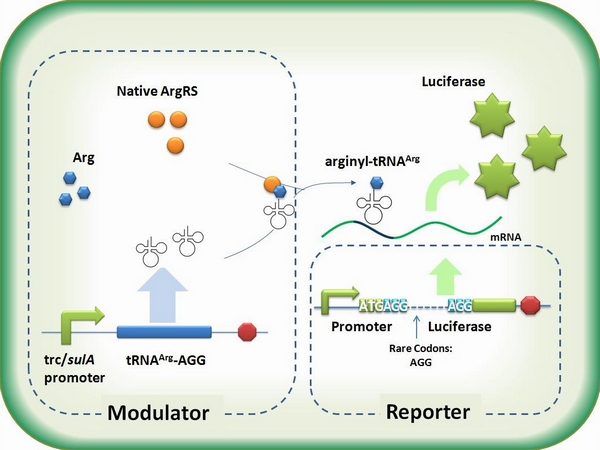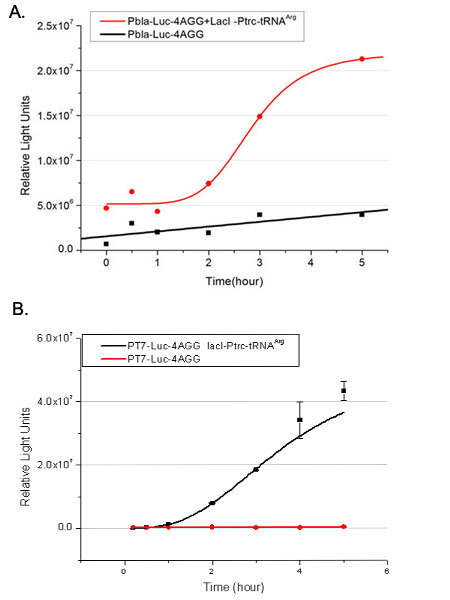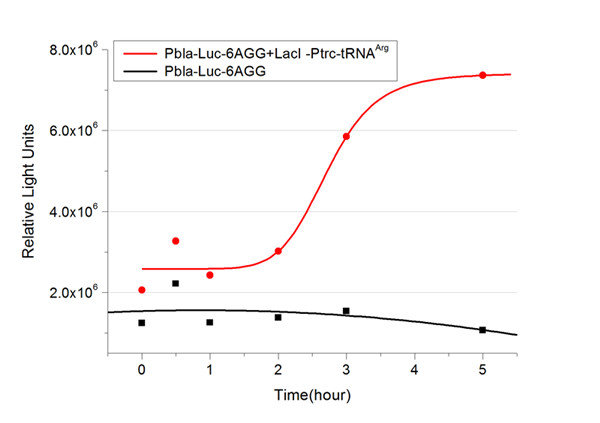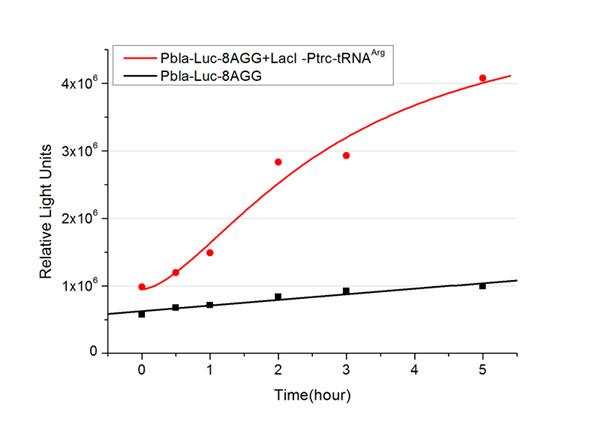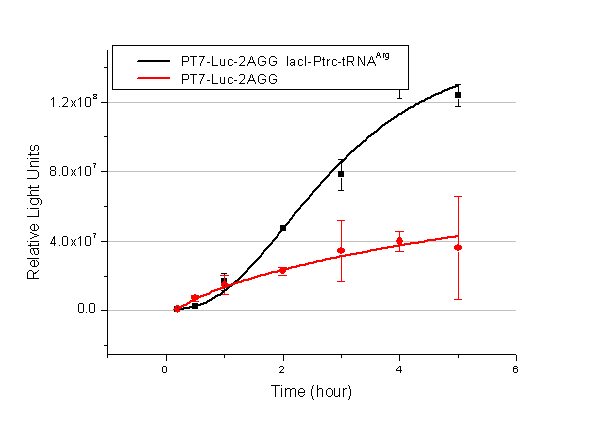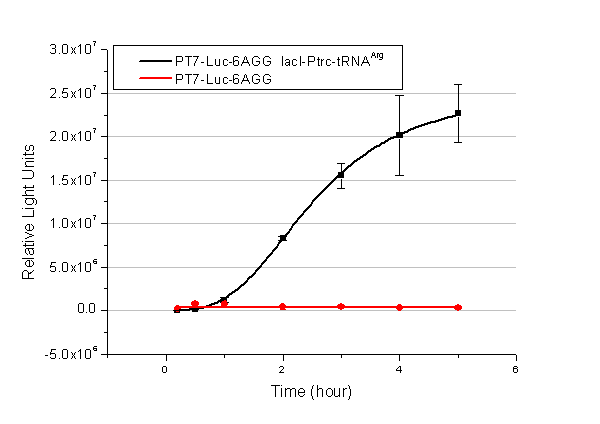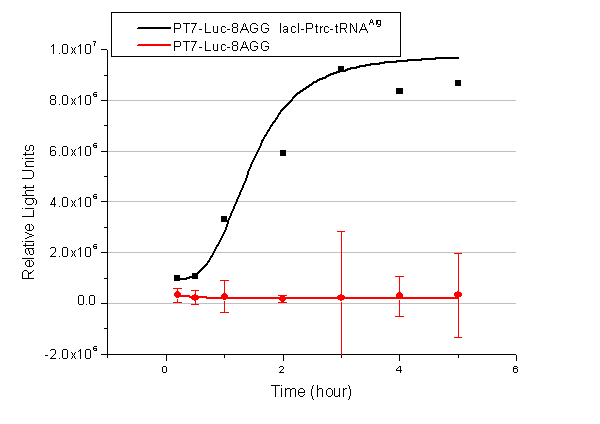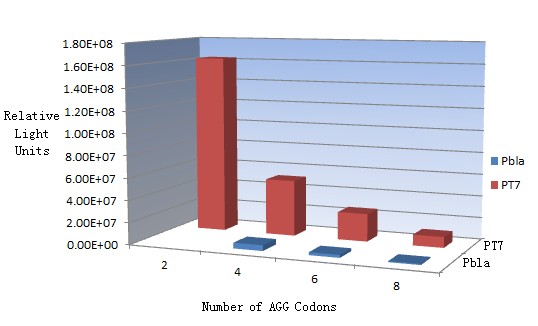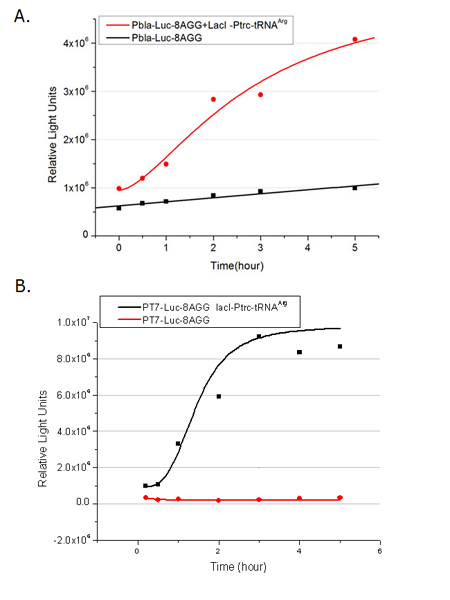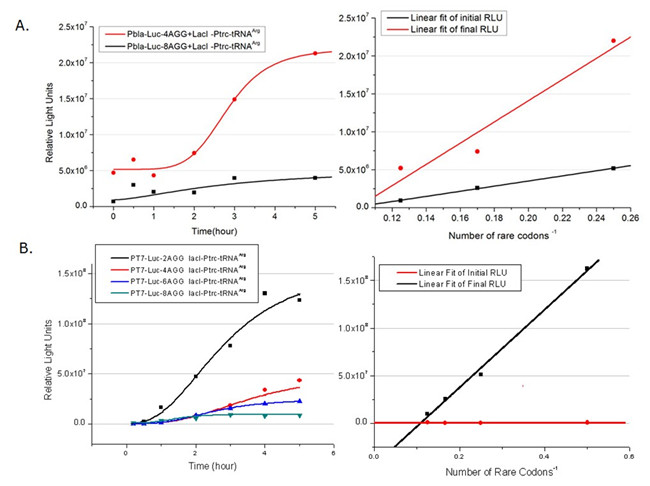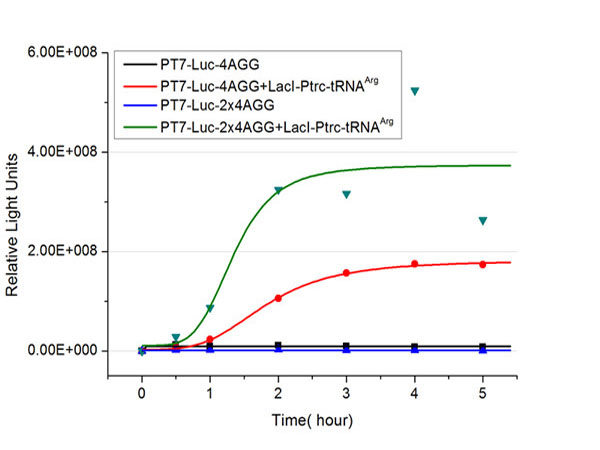Team:SJTU-BioX-Shanghai/Project/Subproject1/Results 2
From 2011.igem.org
(Difference between revisions)
(→tRNA Modulator + Reporter for Quantitative Analysis) |
|||
| Line 19: | Line 19: | ||
'''tRNA Modulator''' and '''Reporter''' for Quantitative Analysis work together to regulate protein biosynthesis. | '''tRNA Modulator''' and '''Reporter''' for Quantitative Analysis work together to regulate protein biosynthesis. | ||
| - | '''tRNA Modulator''' controls rare tRNA amount. In our project, we use ''sulA'' promoter ([http://partsregistry.org/wiki/index.php?title=Part:BBa_K567002 BBa_K567002] ''sulA'' promoter-tRNA<sup> | + | '''tRNA Modulator''' controls rare tRNA amount. In our project, we use ''sulA'' promoter ([http://partsregistry.org/wiki/index.php?title=Part:BBa_K567002 BBa_K567002] ''sulA'' promoter-tRNA<sup>Arg</sup>-AGG) or trc promoter([http://partsregistry.org/wiki/index.php?title=Part:BBa_K567001 BBa_K567001]'' lacI''-Ptrc-tRNA<sup>Arg</sup>) to control rare tRNA amount. |
'''tRNA Modulator''': | '''tRNA Modulator''': | ||
| - | *''sulA'' promoter-tRNA<sup> | + | *''sulA'' promoter-tRNA<sup>Arg</sup>-AGG([http://partsregistry.org/wiki/index.php?title=Part:BBa_K567002 BBa_K567002]) |
| - | *''lacI''-Ptrc-tRNA<sup> | + | *''lacI''-Ptrc-tRNA<sup>Arg</sup>-AGG ([http://partsregistry.org/wiki/index.php?title=Part:BBa_K567001 BBa_K567001] ) |
'''Reporter''' can control two elements: the number of rare codons inserted into luciferase after start codon ATG and the strength of target protein promoter. | '''Reporter''' can control two elements: the number of rare codons inserted into luciferase after start codon ATG and the strength of target protein promoter. | ||
| Line 57: | Line 57: | ||
We have tested luciferin reaction in cells with different combinations of tRNA Modulators and Reporters. We examined the changes in luciferase enzyme activity over time after rare tRNA expression is induced. The amount of luciferase is reflected indirectly by the bioluminescence emitted from the luciferin reaction. Results are shown below: | We have tested luciferin reaction in cells with different combinations of tRNA Modulators and Reporters. We examined the changes in luciferase enzyme activity over time after rare tRNA expression is induced. The amount of luciferase is reflected indirectly by the bioluminescence emitted from the luciferin reaction. Results are shown below: | ||
| - | [[image:11-SJTU-compare-4.jpg|frame|center|''Fig.1'' (A)Enzyme activity of luciferase shown by bioluminescence emitted from the luciferin reaction reflecting the working curve of tRNA Modulator ''lacI''-Ptrc-tRNA<sup> | + | [[image:11-SJTU-compare-4.jpg|frame|center|''Fig.1'' (A)Enzyme activity of luciferase shown by bioluminescence emitted from the luciferin reaction reflecting the working curve of tRNA Modulator ''lacI''-Ptrc-tRNA<sup>Arg</sup> ([http://partsregistry.org/wiki/index.php?title=Part:BBa_K567001 BBa_K567001]) under Reporter P''bla''-Luc-4AGG([http://partsregistry.org/wiki/index.php?title=Part:BBa_K567006 BBa_K567006]). (B)Enzyme activity of luciferase shown by bioluminescence emitted from the luciferin reaction reflecting the working curve of tRNA Modulator lacI-Ptrc-tRNA<sup>Arg</sup> ([http://partsregistry.org/wiki/index.php?title=Part:BBa_K567001 BBa_K567001]) under Reporter PT7-Luc-4AGG ([http://partsregistry.org/wiki/index.php?title=Part:BBa_K567009 BBa_K567009]). The working curve of tRNA Modulator ''lacI''-Ptrc-tRNA<sup>Arg</sup> fits typical titration curve.]] |
Here we use the above two curves as examples to characterize the working curve of tRNA Modulator. Both curves fits typical titration curve, indicating that tRNA Modulator can function as a regulating tool. | Here we use the above two curves as examples to characterize the working curve of tRNA Modulator. Both curves fits typical titration curve, indicating that tRNA Modulator can function as a regulating tool. | ||
| Line 75: | Line 75: | ||
'''Note''':Click to see large figures. | '''Note''':Click to see large figures. | ||
| - | From this experiment, we noticed that the typical working curve of tRNA Modulator can be better observed with IPTG induced tRNA Modulator ''lacI''-Ptrc-tRNA<sup>Arg</sup> (http://partsregistry.org/wiki/index.php?title=Part:BBa_K567001 BBa_K567001) compared with UV excitation induced tRNA Modulator ''sulA'' promoter-tRNA<sup> | + | From this experiment, we noticed that the typical working curve of tRNA Modulator can be better observed with IPTG induced tRNA Modulator ''lacI''-Ptrc-tRNA<sup>Arg</sup> ([http://partsregistry.org/wiki/index.php?title=Part:BBa_K567001 BBa_K567001]) compared with UV excitation induced tRNA Modulator ''sulA'' promoter-tRNA<sup>Arg</sup>([http://partsregistry.org/wiki/index.php?title=Part:BBa_K567002 BBa_K567002]) , though ''sulA'' promoter-tRNA<sup>Arg</sup> responded quicker to signals. We step further to test the influence of different Reporters with tRNA Modulator ''lacI''-Ptrc-tRNA<sup>Arg</sup>. |
| Line 86: | Line 86: | ||
However, the working range of tRNA Modulator is pre-defined by the strength of target protein promoter, T7 promoter and ''bla'' promoter in our project. | However, the working range of tRNA Modulator is pre-defined by the strength of target protein promoter, T7 promoter and ''bla'' promoter in our project. | ||
| - | [[image:11sjtu_Compare_8.png|frame|center|''Fig.8'' (A) Working curve of tRNA Modulator ''lacI''-Ptrc-tRNA<sup> | + | [[image:11sjtu_Compare_8.png|frame|center|''Fig.8'' (A) Working curve of tRNA Modulator ''lacI''-Ptrc-tRNA<sup>Arg</sup> under Reporter P''bla''-Luc-8AGG reflected by bioluminescence emitted from the luciferin reaction. (B) Working curve of tRNA Modulator under Reporter PT7-Luc-8AGG. Here we analyze the influences of strong/weak promoter in the working curve of tRNA Modulator. |
Moreover, strong promoter (T7) of target gene can improve the titration curve of tRNA Modulator, indicating that tRNA Modulator works better under strong target protein promoters. ]] | Moreover, strong promoter (T7) of target gene can improve the titration curve of tRNA Modulator, indicating that tRNA Modulator works better under strong target protein promoters. ]] | ||
| Line 104: | Line 104: | ||
We have obtained PT7-Luc-2x4AGG ([http://partsregistry.org/wiki/index.php?title=Part:BBa_K567021 BBa_K567021]) unexpectedly during our experiment. We have tested the enzyme activity of this part under tRNA Modulator control and have compared the curve with PT7-Luc-4AGG ([http://partsregistry.org/wiki/index.php?title=Part:BBa_K567009 BBa_K567009]) with the same tRNA Modulator. The result is shown below: | We have obtained PT7-Luc-2x4AGG ([http://partsregistry.org/wiki/index.php?title=Part:BBa_K567021 BBa_K567021]) unexpectedly during our experiment. We have tested the enzyme activity of this part under tRNA Modulator control and have compared the curve with PT7-Luc-4AGG ([http://partsregistry.org/wiki/index.php?title=Part:BBa_K567009 BBa_K567009]) with the same tRNA Modulator. The result is shown below: | ||
| - | [[image:11SJTUResultPT7_4_and_8(4-2).jpg|frame|center|''Fig.10'' the comparison of enzyme activity between PT7-Luc-4AG and PT7-Luc-2x4AGG under tRNA Modulator ''lacI''-Ptrc-tRNA<sup> | + | [[image:11SJTUResultPT7_4_and_8(4-2).jpg|frame|center|''Fig.10'' the comparison of enzyme activity between PT7-Luc-4AG and PT7-Luc-2x4AGG under tRNA Modulator ''lacI''-Ptrc-tRNA<sup>Arg</sup>. ]] |
The result reflects the outstanding performance of the newly gained part. Two 4AGGs occurred in the beginning of the gene can bring lower background expression and much higher induced expression compared with luciferase with singe 4AGG insertion. The additional 4AGG does not affect the titration feature of the curve. | The result reflects the outstanding performance of the newly gained part. Two 4AGGs occurred in the beginning of the gene can bring lower background expression and much higher induced expression compared with luciferase with singe 4AGG insertion. The additional 4AGG does not affect the titration feature of the curve. | ||
Revision as of 03:31, 6 October 2011
 "
"
